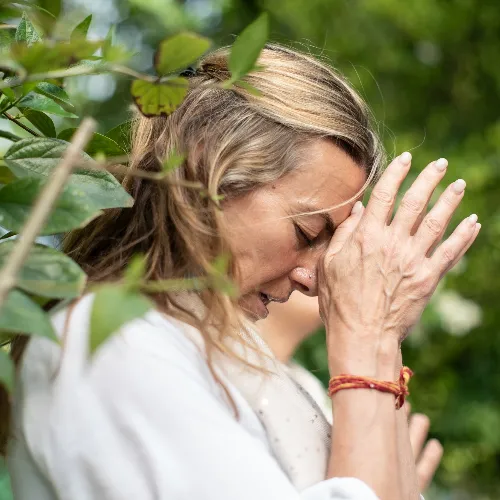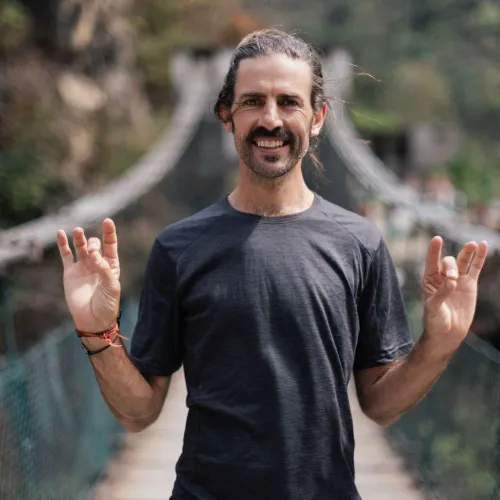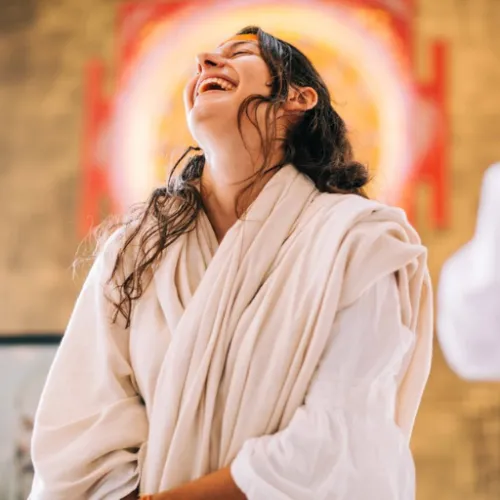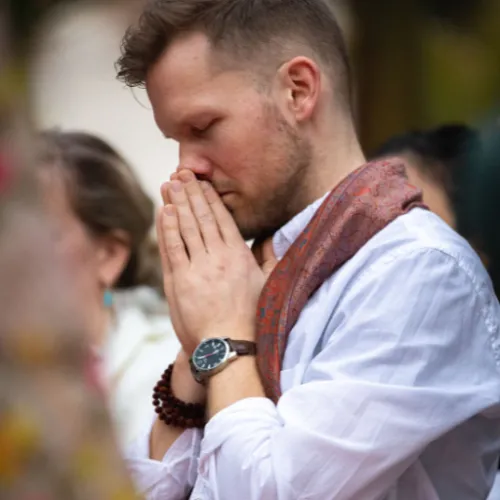


Among the multitude of breathing techniques, one stands out for its invigorating and transformative qualities: Breath of Fire (Kapalabhati Pranayama).
This rhythmic and dynamic breath practice is a powerful tool for cleansing the energetic pathways, energising the body and calming the mind. And, if you are interested in a quick way to shift your state, this is the practice for you.
The Essence of Breath of Fire
Breath of Fire, known as Kapalabhati Pranayama in Sanskrit, translates to "Skull-Shining Breath."
It involves a rapid, forceful exhalation followed by a passive inhalation, creating a rhythmic and continuous flow of breath.
This dynamic breathing technique ignites the fire (Agni) within the body, generating heat and vitality, while purifying the mind.
Benefits of Breath of Fire
Energises the Body:
Breath of Fire oxygenates the blood, increases circulation and creates a surge of energy and vitality throughout the body. It’s particularly beneficial for overcoming lethargy, fatigue, and sluggishness.
Cleanses the Respiratory System:
The rapid and forceful exhalations in Breath of Fire help to clear the lungs of stagnant air, toxins, and impurities, promoting respiratory health and enhancing lung capacity.
Strengthens the Abdominal Muscles:
The vigorous pumping action of the diaphragm and abdominal muscles in Breath of Fire strengthens the core muscles, including the transverse abdominis and obliques, promoting core stability and toning the abdominal region.
Calms the Mind:
Despite its invigorating nature, Breath of Fire has a deeply calming effect on the mind and nervous system. The rhythmic and repetitive nature of the breath helps to quiet mental chatter, reduce stress, and induce a state of deep relaxation and focus.
Balances the Nervous System:
Breath of Fire balances the sympathetic and parasympathetic nervous systems, helping to regulate stress hormones and promote overall nervous system health. It’s an effective tool for anyone experiencing anxiety or depression.
Clears Energetic Blockages:
Breath of Fire purifies the subtle energy channels (nadis) and chakras, clearing away stagnant energy and promoting the free flow of prana (life force energy) throughout the body, allowing for greater vitality and wellbeing.
How to Practice Breath of Fire
Take a Seat: Find a comfortable seated position with a tall spine and relaxed shoulders.
Relax the Abdomen: Take a few deep breaths to relax the abdomen and diaphragm. Place your hands on your knees or thighs.
Engage the Breath: Inhale deeply through the nose to fill the lungs with air. Exhale forcefully and rapidly through the nose by drawing the navel towards the spine, pushing the air out. The inhalation should be passive and spontaneous, allowing the lungs to naturally refill with air.
Focus on the Exhalation: The emphasis in Breath of Fire is on the forceful exhalation, which should be short, sharp, and rhythmic. The inhalation is passive and relaxed.
Maintain a Rhythm: Establish a steady rhythm of breath, maintaining a consistent pace and intensity throughout the practice. Start with a moderate pace and gradually increase the speed as you become more comfortable with the technique.
Duration: Practice Breath of Fire for 1-3 minutes initially, gradually increasing the duration as your practice progresses. Listen to your body and pause if you feel lightheaded or dizzy.
Release & Relax: After completing the practice, take a few moments to sit quietly and observe the effects of the breath.
Tips for Practicing Breath of Fire
Keep the breath rhythmic and continuous, avoiding pauses or interruptions in the flow.
Focus on the exhalation, allowing the inhalation to occur naturally and spontaneously.
Keep the movements of the abdomen and diaphragm smooth and controlled, avoiding any strain or tension in the muscles.
If you are new to Breath of Fire, start with a slower pace and gradually increase the speed as you become more comfortable with the technique.
Practice Breath of Fire on an empty stomach, preferably in the morning or before meals, for optimal benefits.
Precautions and Contradictions
Avoid practising Breath of Fire if you are pregnant, have high blood pressure, epilepsy, or any other medical condition that may be aggravated by rapid breathing.
If you experience any discomfort, dizziness, or lightheadedness during the practice, gently come out of the breath and return to normal breathing.
How to Incorporate Breath of Fire into your Practice
Begin your yoga practice with a few minutes of Breath of Fire to warm up the body, clear out any stagnant energy and declutter the mind.
Use Breath of Fire as a standalone practice to invigorate your system during periods of low energy or lethargy.
Integrate Breath of Fire into specific yoga asanas (poses) to deepen the breath, enhance the benefits of the poses, and cultivate mindfulness and presence. (My suggestion: give it a try in Plank Pose!)
Kapalabhati Pranayama is a potent breathing technique that holds the power to cleanse the system, energise the body and calm the mind and, with regular practice, Breath of Fire can become a transformative tool for cultivating inner strength, enhancing wellbeing and deepening connection with the present moment.
And if you are interested in learning more breathing practices, visit the Pranayama Lab on Sattva Connect. Your Support to an Awakened Life!
FAQs
Q1. What is the Breath of Fire technique?
A: Breath of Fire, or Kapalabhati Pranayama, is a dynamic yogic breathing practice characterized by rapid, forceful exhalations followed by passive inhalations. This technique is known for its energizing and purifying effects on the body and mind.
Q2. What are the benefits of practicing Breath of Fire?
A: Regular practice of Breath of Fire can:
Q3. How do I practice Breath of Fire safely?
A: To practice Breath of Fire safely:
Q4. Are there any precautions to consider?
A: Yes, avoid practicing Breath of Fire if you are pregnant, have high blood pressure, epilepsy, or any other medical condition that may be aggravated by rapid breathing. If you experience dizziness or discomfort, stop immediately and resume normal breathing.


























































































